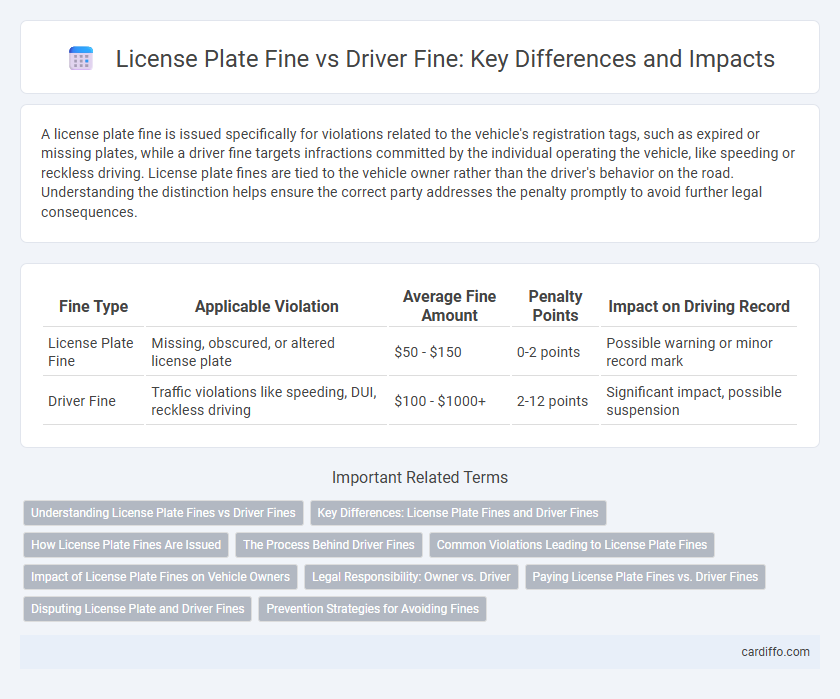A license plate fine is issued specifically for violations related to the vehicle's registration tags, such as expired or missing plates, while a driver fine targets infractions committed by the individual operating the vehicle, like speeding or reckless driving. License plate fines are tied to the vehicle owner rather than the driver's behavior on the road. Understanding the distinction helps ensure the correct party addresses the penalty promptly to avoid further legal consequences.
Table of Comparison
| Fine Type | Applicable Violation | Average Fine Amount | Penalty Points | Impact on Driving Record |
|---|---|---|---|---|
| License Plate Fine | Missing, obscured, or altered license plate | $50 - $150 | 0-2 points | Possible warning or minor record mark |
| Driver Fine | Traffic violations like speeding, DUI, reckless driving | $100 - $1000+ | 2-12 points | Significant impact, possible suspension |
Understanding License Plate Fines vs Driver Fines
License plate fines are issued based on violations recorded through vehicle identification, such as parking infractions or toll evasion, and are directed to the registered owner of the vehicle regardless of who was driving. Driver fines target behavior violations directly attributable to the person operating the vehicle, like speeding or reckless driving, and require identification of the specific driver at the time of the offense. Understanding the distinction between these fines is crucial for accurate accountability and ensuring the appropriate party is held responsible under traffic law enforcement.
Key Differences: License Plate Fines and Driver Fines
License plate fines are penalties imposed specifically for violations related to vehicle registration, such as obscured, missing, or expired plates, whereas driver fines target offenses committed by the individual operating the vehicle, including speeding, reckless driving, or DUI. License plate fines focus on vehicle compliance and registration status, while driver fines address behavior and safety regulations. Understanding these distinctions helps in determining responsibility and applicable penalties under traffic laws.
How License Plate Fines Are Issued
License plate fines are issued when a vehicle's registration tags are expired, missing, or obscured, detected by law enforcement during routine stops or automated traffic cameras. These fines differ from driver fines as they specifically target the vehicle's documentation rather than the driver's behavior. Authorities rely on license plate recognition technology to identify violations efficiently and enforce compliance with vehicle registration laws.
The Process Behind Driver Fines
Driver fines are issued based on violations identified through traffic enforcement methods such as speed cameras, police stops, or automated license plate recognition systems. Once a violation is detected, authorities verify the driver's identity and issue the fine accordingly, differentiating from license plate fines which target vehicle owners regardless of who was driving. The process ensures accountability by linking infractions directly to the responsible driver, often involving administrative review and opportunities for appeal.
Common Violations Leading to License Plate Fines
Common violations leading to license plate fines include obscured or unreadable plates, expired registration tags, and improper display of license plates. Vehicle owners often face penalties for using counterfeit or altered plates, as well as for failing to attach front or rear plates when required by law. Enforcement agencies prioritize these infractions due to their impact on vehicle identification and law enforcement efforts.
Impact of License Plate Fines on Vehicle Owners
License plate fines directly affect vehicle owners by increasing their financial burden and potentially leading to higher insurance premiums. Unpaid license plate fines can result in vehicle registration suspensions, limiting the owner's ability to legally operate the vehicle. These penalties often encourage timely compliance but may disproportionately impact low-income individuals, creating challenges in vehicle ownership and mobility.
Legal Responsibility: Owner vs. Driver
License plate fines typically hold the vehicle owner legally responsible for violations such as unpaid tolls or expired registrations, regardless of who was driving at the time. Driver fines are imposed directly on the individual operating the vehicle for infractions like speeding or reckless driving, establishing personal accountability. Understanding the distinction between owner and driver liability is crucial for addressing legal responsibilities effectively in traffic violation cases.
Paying License Plate Fines vs. Driver Fines
Paying license plate fines typically involves fees related to vehicle registration violations, such as expired tags or improper display, and these fines directly impact the vehicle owner regardless of who was driving. Driver fines are issued for violations tied directly to the individual's behavior behind the wheel, such as speeding or reckless driving, and their payment can affect the driver's record and insurance rates. Understanding the distinction between these fines is crucial for addressing penalties appropriately and avoiding further legal complications.
Disputing License Plate and Driver Fines
Disputing license plate fines often requires presenting evidence that the vehicle was not responsible for the violation, such as proving a plate was stolen or cloned. Driver fines typically focus on the individual's actions, so contesting them demands demonstrating that the driver was not in control of the vehicle at the time or that the infraction did not occur as alleged. Understanding local traffic laws and providing relevant documentation are crucial for successfully challenging both types of fines.
Prevention Strategies for Avoiding Fines
Implementing preventive measures such as regular vehicle inspections and ensuring that license plates are clearly visible and properly attached reduces the risk of license plate fines. Educating drivers on traffic laws, encouraging compliance with speed limits, and using technology like dashboard cameras can help avoid driver fines by promoting responsible behavior. Maintaining updated registration and addressing any legal infractions promptly serve as effective strategies to minimize overall fine occurrences.
License plate fine vs driver fine Infographic

 cardiffo.com
cardiffo.com